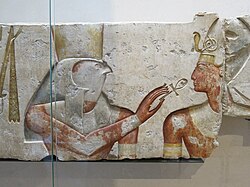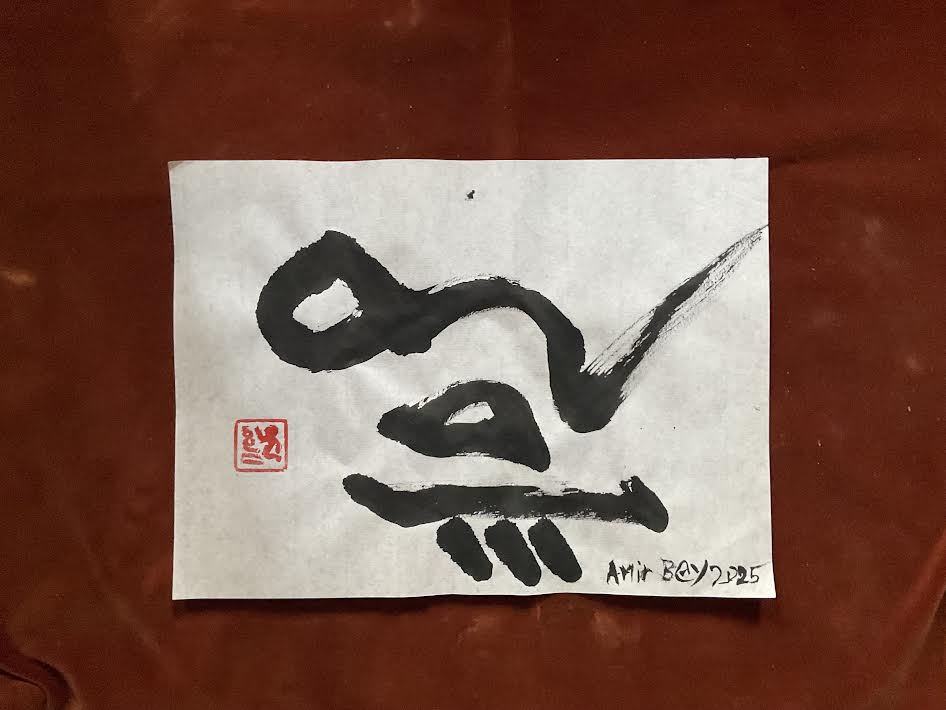EGYPTIAN SPACETIME
Special for THE NEW TIMES HOLLER!
By
© Amir Bey, 2025
August 6
A Medu Netcher Time-Arrow Shot from the Solar Arc’s Bow
|
There is a possibility that the Egyptians, as indicated by their use of certain hieroglyphs, created the earliest articulation of Spacetime concepts. The importance of “Everlasting Life” in their religion, and with their vision of the Afterlife expressed in their art and literature, led to this understanding and are testament to this perspective.
|

LIFE EVERLASTING
Heru (Horus) giving Everlasting Life (the Ankh) to Ramesses II
|
Why call it “Spacetime?” Throughout their history they wished the deceased to, as it is translated in English, Live “Forever and Ever.” However, if the hieroglyphs for that formula is examined, we see that they were not just repeating the same phrase to signify “Forever,” could be distinguished as “Infinity,” and “Eternity.”
How should Forever be written? |
MEDU NETCHER: THE GODS' WORDS
The text below is from English to Middle Egyptian Dictionary, Bill Petty, Ph.D. page 82 The font often selected barely shows the three seeds beneath the Earth.
 We often overlook the sense of an ancient culture's like Egypt's intention for the sake of convenience or to have that era's ideas conform to ours. We often overlook the sense of an ancient culture's like Egypt's intention for the sake of convenience or to have that era's ideas conform to ours.
|
The hieroglyphs that denote the Spatial aspect of “Everlasting,” that I am calling INFINITY, has a cobra (approximately pronounced tchet) over a character for the surface of the Earth (tau) with three dots that represent seeds lying underneath. One meaning of the cobra is a never-ending circle; thus, we have the Infinity of Space, of limitless land, its eternal bounty symbolized by 3 seeds beneath the Earth. The semi-circular shape is a loaf of bread, phonetic for the T sound when pronounced, otherwise an indication that the word is feminine.
The hieroglyphs that denote Time that I am calling ETERNITY, often had a guinea fowl in front of the two wicks (approximately pronounced HeH, and niHeH) with the Sun symbol (not pronounced) between them. I am not sure what association a guinea fowl has with time or Eternity; this may be merely phonetic. But the Sun between two coiled chords suggests the twisting, coursing route of cycles, time is symbolized. Here we can see that time was seen cyclically, with the Sun having a never-ending recurring movement.
|
WRITING BY HAND
This is how are the hieroglyphs for “Eternity” appear in A Concise Dictionary of Middle Egyptian, by Raymond O. Faulkner on Page 217. All of his entries are impressively handwritten clearly by him. Note the visibility of the three “seeds,” which were sometimes written as dots or small circles.

|
EGYPTIAN SPACETIME AS WRITTEN BY MODERN HAND AND BRUSH
|
Here are Egyptian concepts of Space (Infinity) and Time (Eternity) explored through brush, and Sumi ink on rice paper. In my renderings, I chose to emphasize the seeds; this is the prerogative of the hand!
UNLIMITED SPACE Infinity, seen as limitless space. Sumi ink on rice paper, Amir Bey, 2025 Infinity, seen as limitless space. Sumi ink on rice paper, Amir Bey, 2025
|
|
RECURRING CYCLES

The hieroglyph for a candle wick symbolized a cyclic or recurring action. With the derterminative of the Sun, this dealt with Time. Sumi ink on rice paper, Amir Bey, 2025
|
In most English renderings, everlasting is translated as “Tutankhamun Living Forever and Ever…” yet, “Forever and Ever” does not describe the important distinctions of Space and Time that was expressed in their hieroglyphs, which again, can be defined as Infinite, Eternal, Life. There is nothing of the Finite in their concepts of Space and Time, not intellectually, nor in the imagery of the hieroglyphics.
It is clear that with the importance of the Afterlife in their religion, they explored Infinity and Eternity in various ways. They saw that Night was a period when the soul, signified by the Sun being swallowed, was transformed through its journey across the night sky, as it battled Apep, a snake that represented evil. After winning those nightly battles, a renewal of the soul happened at dawn, symbolized by Kephera, reaching its climax as Ra at noon, While as Atum, the Sun was setting, to begin its night journey. In this way, life was a recurring cycle, of birth, life, and death, to again be reborn at dawn.
The stars of the night sky were seen as the souls of deceased pharaohs, and in later more egalitarian times, the stars were believed to be the souls of the deceased who had lived in Maat, a just and correct life.
In modern physics, we think of Spacetime ideas as being new. Yet, the Egyptians, more than 5,000 years ago had explored them through their religion, art, literature, and philosophy of life, without the use of radio or optical telescopes, atom smashers, and other technologies. Their notion of Spacetime came from observing and revering time’s unending recurrence to conceive of the limitless expanse of Space and Time.
This suggests that modern physicists may arrive at the solutions to their queries about Spacetime not only through mathematics. Discoveries may emerge from devoted and consistent contemplation of life’s manifestations, by expanding on the quantum mechanics of life, such as String Theory, thereby projecting the smallest features of time cycles onto larger conceptions of Eternity and Infinity that along with mathematical calculations to arrive at Maat, Truth.
*I prefer Kuma to Kmt, Kemet, Kemetic, etc. Kuma is how they likely pronounced it. Ta-Meri - “The beloved Land” was another name they used. In English, I use Egypt, which is derived from a sacred site, “Hewt-guptah” “Temple of Ptah.”
#eternity
#Infinity
#egyptiantime
#hieroglyphs
#amirbey
#egypitiandimensions
#kmt
#kemet
#kuma
#spacetime
| | | | |